Cooloola—Species assessment
Species surveys were conducted to detect priority threatened species in burnt habitats. Unburnt habitats were also surveyed as a comparison, to see if they were acting as a refuge for recovery. Surveys were also used to establish broader spatial distributions, relative population size and breeding status where possible.
A total of 12 species of flora and fauna were surveyed, as well as invertebrate species of concern. Summary results are provided for the following species:
- Eastern ground parrot (Pezoporus wallicus wallicus)
- Southern emu-wren (Stipiturus malachurus)
- Wallum acid frogs
For the results of surveys for all species, read the full report Bushfire Recovery 2020-2021: Priority actions for threatened species in the Cooloola section of Great Sandy National Park, South East Queensland .
Eastern ground parrot (Pezoporus wallicus wallicus)
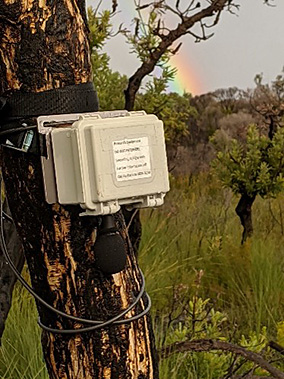
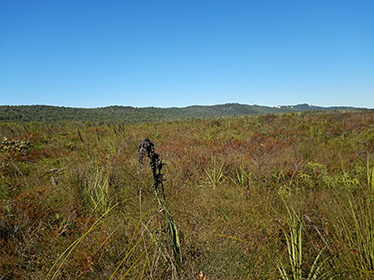
The eastern ground parrot is listed as Vulnerable under the Nature Conservation Act 1992. Ground parrot populations have declined due to habitat clearance from coastal development and increased predation, especially from feral cats and foxes. In Queensland the ground parrot occurs in dense coastal heathlands feeding on seeds from a variety of plant species including sedges. More than 15% of ground parrot habitat was impacted by the 2019–20 bushfires in the Great Sandy and Noosa National Parks, which removed important food resources and protective vegetation cover from predators.
At Cooloola, post-fire surveys were undertaken across 40 sites of suitable habitat during 2020 and 2021 to detect the distinctive call of ground parrots. Trained ecologists listened for bird calls in a standardised manner and set up acoustic recorders to capture sounds daily at sunset and sunrise. The results were then analysed to estimate the number of individual birds calling.
Ground parrots were present at 84% of the sites surveyed, and were recorded more at unburnt sites than burnt sites. The highest estimated densities were in areas that were not impacted by the 2019–20 bushfires. Previous studies have shown that after a fire, the number of ground parrots increase over time (up to 5–8 years) at which time the required habitat structure has recovered with good seasonal availability of seed resources.
To support the recovery of the ground parrot populations at Cooloola, it is recommended that the burnt coastal heath is protected from future fires for seven to ten years to enable the vegetation to regenerate, mature and reproduce. The strategic use of planned burns will be used to sustain different age classes of suitable habitat across Cooloola with ongoing seed production and cover from predators. Controlling pest animals such as foxes, as well as invasive weeds that degrade habitats and compete with native species, will be part of the ongoing park management program. The continued monitoring of ground parrots is important to track the recovery of ground parrot populations over time.
Southern emu-wren (Stipiturus malachurus)
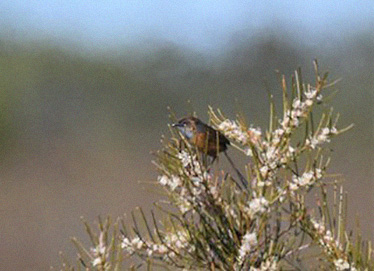
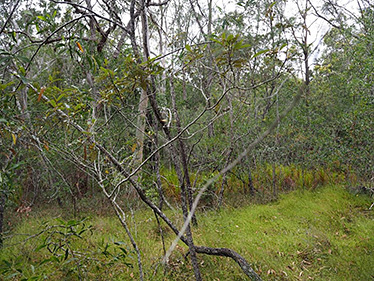
The southern emu-wren is listed as Vulnerable under the Nature Conservation Act 1992. It has become increasingly restricted in its range due to habitat loss, degradation and increased predation from feral predators. The southern emu-wren is a cryptic species that occurs in the heaths and swamplands of Cooloola, feeding on insects and spiders gleaned from thick foliage. More than 15% of their suitable habitat was impacted by the bushfires, reducing the food resources, available protective plant cover and increasing the risk from predators.
To assess the presence of southern emu-wrens after the bushfires, surveys were undertaken across 27 sites of suitable habitat during 2020 and 2021. Acoustic recorders were set up at each site to record sounds for one-hour at dawn each day. In addition, trained ecologists conducted 10 surveys across 6 sites to detect any southern emu-wren calls made in response to playing a pre-recorded call of the same species.
Acoustic recordings from 21 sites have been analysed and revealed that southern emu-wrens were detected at 1 burnt site and 1 unburnt site. The birds were not detected from the surveys that tested the playback of their calls, including in an area where they have been known to occur.
Southern emu-wrens are difficult to detect in the dense vegetation they prefer, and sightings are very dependent on the time of day and weather conditions. Ongoing monitoring with acoustic recorders is recommended to establish the current status of this species at Cooloola. It is also recommended that the risk of a future bushfires to a known core habitat area associated with Teewah Creek, which remains an unburnt refugia, is a priority for fire management in the park.
Wallum acid frogs
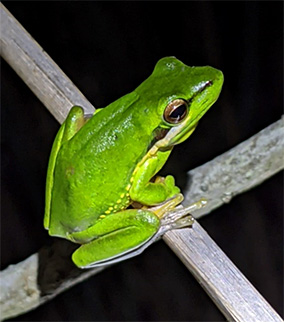

The wallum froglet (Crinia tinnula), wallum sedgefrog (Litoria olongburensis) and wallum rocketfrog (Litoria freycineti) are listed as Vulnerable and the Cooloola sedgefrog (Litoria cooloolensis) is listed as Near Threatened under the Queensland Nature Conservation Act 1992. Wallum sedgefrog (Litoria olongburensis) is also listed as Vulnerable under the Commonwealth Environment Protection and Biodiversity Conservation Act 1999.
The wallum acid frogs are restricted to the nutrient poor and acidic water bodies and peat bogs that occur in coastal wet heath, wallum and dune wetlands. A significant proportion of their suitable habitat (>15%) was impacted by the 2019–20 bushfires. Ash and sediment run-off can alter water quality, chemistry and movement to the extent that the wallum acid frogs cannot tolerate it.
Post-fire surveys were conducted at 59 sites in 2020 and 33 sites in 2021, which included burnt and unburnt wetlands and wet heath. Surveys used active searches, listening for frogs and the deployment of acoustic recorders to detect calls. The analysis of the results revealed that while frogs were present in both burnt and unburnt habitats, most sites did not contain wallum acid frogs. The wallum froglet was heard throughout the Winter–Spring seasons at both burnt and unburnt sites. Overall, the wallum sedgefrog was the most frequently recorded acid frog species across both unburnt and burnt habitats.
The ability to detect calls of the wallum sedgefrog, wallum rocketfrog and Cooloola sedgefrog are typically enhanced within 7 days of heavy rainfall over the warmer months. This was difficult given the low level of rainfall during the survey period, which left some swamps dry. The impacts of the prolonged drought on frog populations prior to the 2019–20 bushfires are poorly understood and ecologists are concerned that it may reduce their capacity for post-fire recovery. The predicted increase in fire frequency and intensity is of additional concern. Ongoing monitoring to track the recovery of the wallum acid frogs is a high priority. Monitoring for feral pigs continues so control measures are implemented when pigs are detected in the Cooloola area.


